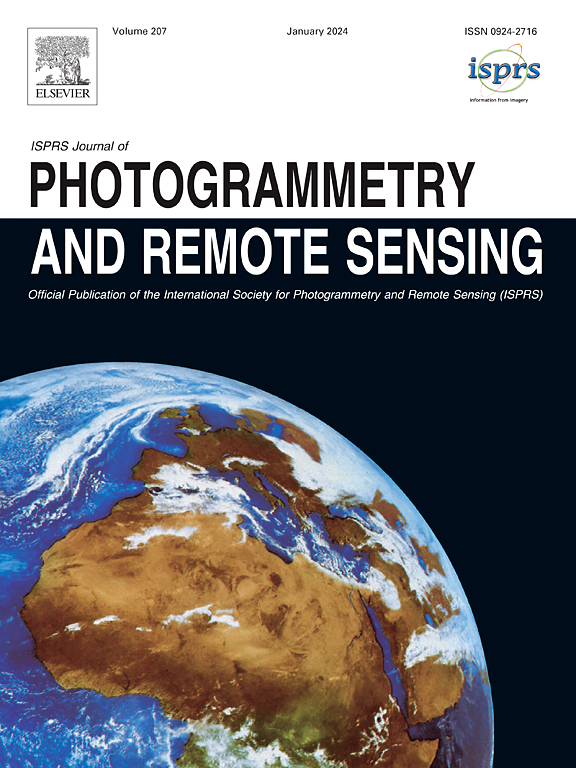航空中波红外低重叠阵列扫描图像的相位一致图像拼接方法
IF 12.2
1区 地球科学
Q1 GEOGRAPHY, PHYSICAL
ISPRS Journal of Photogrammetry and Remote Sensing
Pub Date : 2025-06-13
DOI:10.1016/j.isprsjprs.2025.06.007
引用次数: 0
摘要
随着成像仪制造技术的飞速发展,中波红外阵列扫描图像被广泛应用,以体现丰富的热辐射地理信息。由于MWIR成像探测器的视场有限,为了将多幅重叠图像组合成更大的视场图像,图像拼接是必不可少的。然而,MWIR图像同时存在图像质量差和信噪比(SNR)低的问题,这对现有的拼接方法提出了重大挑战,特别是在低重叠条件下。为了克服这些挑战,本研究提出了一种基于位置定位系统(POS)图像位置的航空MWIR阵列扫描图像相位一致性(PC)图像拼接方法。首先,实现了一种联合边角PC (CEPC)特征检测策略,增强了MWIR图像的特征点检测能力;随后,开发了分数平均PC定位和方向直方图(FAPC-LOH)描述符来生成鲁棒特征描述符。利用图像初始位置对重叠区域内的图像对和匹配对应进行滤波,防止不匹配,保证特征点的可靠性。将有效特征点纳入基于拓扑分析的全局一致性矩形对齐模型中,得到矩形拼接结果。最后,利用地面控制点对拼接图像的平面投影误差进行校正。本文对从三个城市收集的六个MWIR数据集进行了严格的评估,包括不同的场景、飞行高度、成像时间和重叠率。结果表明,基于pc机的方法将平均内嵌数(MNI)提高了5 ~ 12倍,将匹配成功率(RSM)提高了21.2 ~ 46.93%,平均RSM达到99.74%。在6个数据集上,它的平均对齐均方根误差(RMSE)为2.11像素,平均几何定位精度为1.26 m (RMSE)。此外,对准结果优于代表性的拼接算法和流行的商业软件,实现了更好的全局和局部对准,并提高了定位精度。本文章由计算机程序翻译,如有差异,请以英文原文为准。
Phase congruency image mosaicking approach for aerial mid-wave infrared low-overlap array scanning images
With the rapid development of imager manufacturing technology, mid-wave infrared (MWIR) array scanning images have been widely used to embody abundant thermal radiation geographic information. Due to the limited field of view (FOV) of the MWIR imaging detector, image mosaicking is essential for combining multiple overlapping images into a larger FOV image. However, MWIR images simultaneously suffer from poor image quality and a low signal-to-noise ratio (SNR), presenting significant challenges to existing mosaicking methods, particularly under low-overlap conditions. To overcome these challenges, this study proposes a robust phase congruency (PC) image mosaicking approach for aerial MWIR array scanning images based on image positions derived from Position Orientation System (POS). First, a joint corner-edge PC (CEPC) feature detection strategy is implemented to enhance feature point detection in MWIR images. Subsequently, a fractional average PC localization and orientation histogram (FAPC-LOH) descriptor is developed to generate robust feature descriptors. Additionally, image pairs and matching correspondences within overlapping regions are filtered using the initial image positions to prevent mismatches and ensure the reliability of feature points. Valid feature points are incorporated into the global consistency rectangling alignment model based on topology analysis to obtain the rectangular mosaicking results. Finally, ground control points (GCPs) are used to correct the planar projection error of the mosaicked images. The proposed mosaicking method is rigorously evaluated on six MWIR datasets collected from three cities, encompassing diverse scenarios, flight altitudes, imaging times, and overlap rates. Results demonstrate that our PC-based approach improves the mean number of inliers (MNI) by 5–12 times, increases the rate of successful matching (RSM) by 21.2–46.93% with an average RSM of 99.74%. It also achieves an average alignment root mean square error (RMSE) of 2.11 pixels and an average geometric positioning accuracy of 1.26 m (RMSE) across six datasets. Furthermore, the alignment results outperform those of representative mosaicking algorithms and popular commercial software, achieving superior global and local alignment along with enhanced positioning accuracy.
求助全文
通过发布文献求助,成功后即可免费获取论文全文。
去求助
来源期刊

ISPRS Journal of Photogrammetry and Remote Sensing
工程技术-成像科学与照相技术
CiteScore
21.00
自引率
6.30%
发文量
273
审稿时长
40 days
期刊介绍:
The ISPRS Journal of Photogrammetry and Remote Sensing (P&RS) serves as the official journal of the International Society for Photogrammetry and Remote Sensing (ISPRS). It acts as a platform for scientists and professionals worldwide who are involved in various disciplines that utilize photogrammetry, remote sensing, spatial information systems, computer vision, and related fields. The journal aims to facilitate communication and dissemination of advancements in these disciplines, while also acting as a comprehensive source of reference and archive.
P&RS endeavors to publish high-quality, peer-reviewed research papers that are preferably original and have not been published before. These papers can cover scientific/research, technological development, or application/practical aspects. Additionally, the journal welcomes papers that are based on presentations from ISPRS meetings, as long as they are considered significant contributions to the aforementioned fields.
In particular, P&RS encourages the submission of papers that are of broad scientific interest, showcase innovative applications (especially in emerging fields), have an interdisciplinary focus, discuss topics that have received limited attention in P&RS or related journals, or explore new directions in scientific or professional realms. It is preferred that theoretical papers include practical applications, while papers focusing on systems and applications should include a theoretical background.
 求助内容:
求助内容: 应助结果提醒方式:
应助结果提醒方式:


